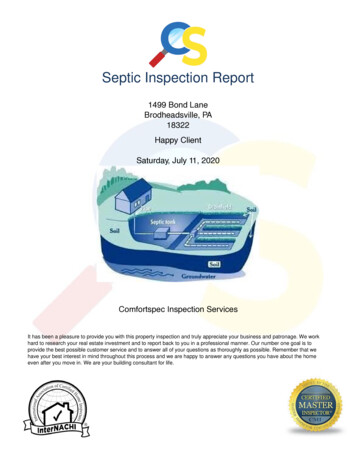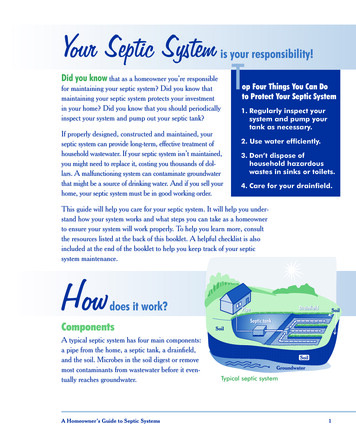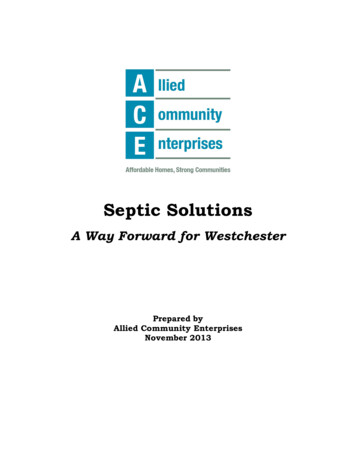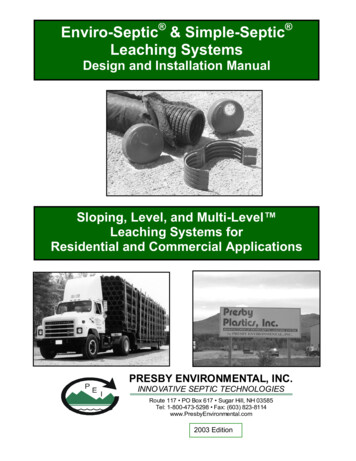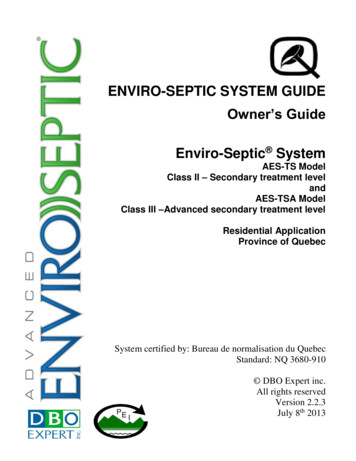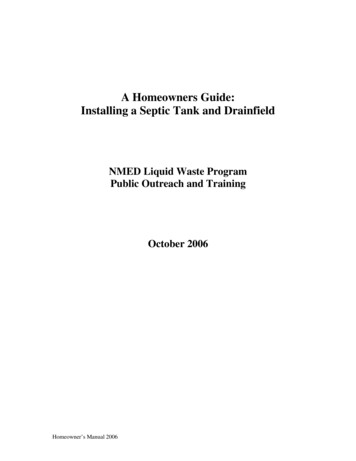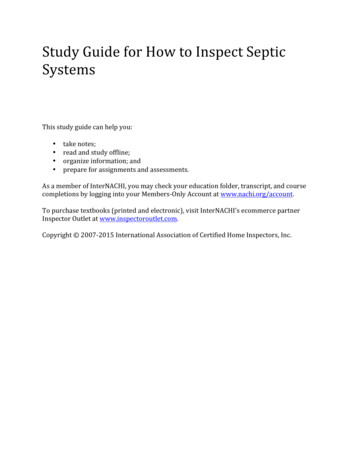
Transcription
Study Guide for How to Inspect SepticSystemsThis study guide can help you: take notes;read and study offline;organize information; andprepare for assignments and assessments.As a member of InterNACHI, you may check your education folder, transcript, and coursecompletions by logging into your Members-Only Account at www.nachi.org/account.To purchase textbooks (printed and electronic), visit InterNACHI’s ecommerce partnerInspector Outlet at www.inspectoroutlet.com.Copyright 2007-2015 International Association of Certified Home Inspectors, Inc.
Student Verification & InteractivityStudent VerificationBy enrolling in this course, the student hereby attests that they are the person completingall coursework. They understand that having another person complete the coursework forthem is fraudulent and will result in being denied course completion and correspondingcredit hours.The course provider reserves the right to make contact asnecessary to verify the integrity of any informationsubmitted or communicated by the student. The studentagrees not to duplicate or distribute any part of thiscopyrighted work or provide other parties with the answersor copies of the assessments that are part of this course. Ifplagiarism or copyright infringement is proven, the studentwill be notified of such and barred from the course and/orhave their credit hours and/or certification revoked.Communication on the message board or forum shall be ofthe person completing all coursework.
Introduction"Septic"In this course, the term "septic" is used to describe alltypes of systems (anaerobic and aerobic). The term"septic" is a commonly used term to describe all typesof septic systems and components, even though itshould only be used when describing anaerobicsystems. The term "septic" actually refers to theanaerobic bacterial environment that exists in thetreatment tank, which decomposes the wastedischarged into the tank.Septic SystemsThe French are considered the first to use an underground septic tank system in the 1860s.By 1880, two-chamber septic systems were being used in the United States. Today, nearlyone in four households in the United States depends on an individual septic (onsite)wastewater treatment system or small community cluster system to treat wastewater.In 2007, 20 percent (26.1 million) of total U.S. housing units were served by septic systems.This is an increase of 1.54 million septic systems since 1985. In 2007, 22 percent (1.6million) of all housing units less than 4 years old used septic systems. In 2007, 46 percent(10.1 million) of occupied housing units with septic systems were located in the southernregion of the United States.In far too many cases, the septic systems in the U.S. are installed and largely forgotten —until problems arise. EPA concluded in its 1997 Report to Congress that "adequatelymanaged decentralized wastewater systems are a cost-effective and long-term option formeeting public health and water quality goals, particularly in less densely populated areas."The difference between a failed system and a functional system is the implementation of aneffective wastewater maintenance and inspection program. Such a program, if properlyexecuted, can protect public health, preserve valuable water resources, and maintaineconomic vitality in a community.When used properly, an onsite system can function very well for many years. If usedimproperly, the system will fail and cause conditions that threat human health and theenvironment. Inspection and maintenance is key to ensuring that septic systems functionproperly.
Onsite wastewater treatment and disposal systems are inspected routinely across theUnited States during a real estate transaction. There are several national associations thathave developed standards for the inspection and maintenance of septic systems. Everystate regulates the installation of septic systems and most require strict certification andtraining of installers and inspectors.A septic inspection leads to an inspection report that provides the client with informationabout the type and condition of the onsite wastewater treatment system as observed at thetime of the inspection. Recommendations for further evaluation or corrective actionsregarding the systems and components might be included in the report.It should be the intention of the inspector to provide as much accurate, unbiasedinformation about the septic system’s condition so that the client can make smart, informeddecisions. In your particular state or county, the septic inspector might not be required todeclare a system to be malfunctioning, failed or non-compliant. This will likely be theresponsibility of the local administrative authority such as the local or state healthdepartment. The inspector simply reports any observed condition that may represent anindication of a malfunctioning system to their client and the local health department soonafter (typically within 24 hours) the septic inspection.A typical septic inspection is: An objective evaluation of the onsite wastewater treatment system based upon theinspector’s experience and knowledge;An evaluation of each inspected component of the system; andA conclusion about the system’s condition.A typical septic inspection is NOT: A warranty or guarantee that the system will properly function for any period oftime in the future; andA certification of the system’s installation or performance.Two Types of InspectionsHow should septic systems be maintained? How do you know if a septic system is workingproperly? This training course answers these questions by providing instruction forevaluating and maintaining onsite (septic) wastewater treatment systems. This trainingcourse provides instructions for gathering information about the system, locatingcomponents of the system, checking the plumbing system inside the house, evaluating theperformance and condition of the components of the system, applying inspectiontechniques, and recommending routine maintenance and inspections.This training course for inspecting onsite (septic) wastewater treatment systems describestwo types of inspections:
1. A maintenance inspection to determine the need for pumping and minor repairs;and2. A complete functional inspection typically used during a real estate transfer.Inspector LogoThe Septic Inspector logo is available for use by all InterNACHI certified members whosuccessfully complete this course, including its final exam. Download the logofrom www.nachi.org/logos.ObjectiveAfter successful completion of the training, the student will be able to perform two types ofinspections of onsite wastewater (septic) treatment systems: maintenance inspections; andfunctional inspections.For Residential Home InspectorsThe routine maintenance inspection is designed for residential home inspectors to:1. perform a routine maintenance inspection using visual-only, non-invasiveinspection techniques; and
2. report to their client:o the location of the system components;o how the system works, ando maintenance recommendations.For EveryoneInspection and maintenance is key to ensuring that septic systems function properly. Thistraining is for everyone with an interest in inspecting and maintaining functional onsitewastewater (septic) treatment systems. Home inspectors can use this training to provide valuable information to theirclients with respect to routine inspections and maintenance of their system.Septic contractors can use the training to learn how to evaluate the condition of thesystem and determine the need for regular maintenance as well as repair.This training can also help to prepare for a state certification examination. It isintended to provide reliable information to inspectors, homebuyers, septiccontractors, homeowners, and interested parties.Regularly inspected and properly maintained septic systems help to protect public health,preserve valuable water resources, and maintain economic vitality in acommunity. Properly trained home inspectors play a vital role in a homeowner’s regularhome maintenance plan by performing routine maintenance inspections.AcknowledgementsThis training course is based upon several documents that are available to the public fromthe following sources: New Jersey Department of Environmental ProtectionPennsylvania Septage Management AssociationRutgers Cooperative ExtensionUnited States Environmental Protection AgencyRhode Island Department of Environmental ManagementGeorgia Department of Community HealthChester County Health Department, Bureau of Environmental Health ProtectionSpecial thanks to InterNACHI Member Mark D. Nahrgang of Kingdom Inspections.Course author: Ben Gromicko at ben@internachi.org. Comments and suggestions areappreciated.InterNACHI courses: www.nachi.org/education.Two Types of Inspections
This training course describes two types of inspection that can be performed by properlytrained inspectors:1. maintenance inspections; and2. functional inspections.The routine maintenance inspection is well suited for a residential home inspector. Amaintenance inspection is used to locate system components, describe how the systemfunctions and how it can be maintained regularly. The functional inspection is usedprimarily during property transfers, includes a maintenance inspection, and designedprimarily for septic contractors.Maintenance InspectionsThe maintenance inspection determines the need for pumping and to identify minorproblems before they become major defects that threaten human health and theenvironment.There are two maintenance inspection subtypes:1. A first maintenance inspection; and2. A routine maintenance inspection.For the Home InspectorThe first maintenance inspection is designed for the home inspector to report to their client(1) the location of the system components, (2) how the system works, and (3) maintenancerecommendations using visual-only, non-invasive inspection techniques.For the Septic ContractorThe routine maintenance inspection assumes that the components have already beenlocated.First Maintenance Inspection1.2 First Maintenance Inspection (designed for a home inspector)1. Gather Information Before the Inspectiono Health departments and local authoritieso Ask the homeowner2. Evaluate the Plumbing of the Houseo Inspect the plumbing system of the houseo Leaking fixtures and equipment3. Locating the Components of the System
Locate and access the treatment tank, cesspool or seepage pitEffluent delivery and distributionLocate the absorption areaRisers, filters and baffles4. Scheduling Maintenance Inspections5. Report to the ClientooooRoutine Maintenance Inspection1. Evaluate the Plumbing of the House Inspect the plumbing system of the houseEstimate water useChanging fixtures with water conservation devicesLeaking fixtures and equipment2. Evaluate the System Components Inspect the treatment tankInspect the cesspool or seepage pitInspect the holding tankInspect the dosing and siphon tanks and pumpsInspection of mound, subsurface bed and trench systemsHydraulic load testAccessory components and alternate technologies3. Report to the ClientFunctional InspectionsFor the Septic ContractorThe functional inspection is used primarily during a property transfer to protect theconsumer and identify systems in need of correction and further evaluation. A functionalinspection determines whether a system serves the house adequately.1. Gather Information Before the Inspection Health departments and local authoritiesAsk the homeowner2. Evaluate the Plumbing of the House Inspect the plumbing system of the houseEstimate water use
Changing fixtures with water conservation devicesLeaking fixtures and equipment3. Locating the Components of the System Locate and access the treatment tank, cesspool or seepage pitEffluent delivery and distributionLocate the absorption areaRisers, filters and baffles4. Evaluate the System Components Inspect the treatment tankInspect the cesspool or seepage pitInspect the holding tankInspect the dosing and siphon tanks and pumpsInspection of mound, subsurface bed and trench systemsHydraulic load testAccessory components and alternate technologies5. Scheduling Maintenance Inspections6. Report to the ClientTools NeededTools NeededTo inspect the plumbing system in the house: FlashlightCalculatorStopwatchWater pressure and flow meterTo access the components of the system: ShovelMetal prod (steel rod)To check the tank: Sludge measuring deviceScum measuring device
Latex glovesPumping service with pump truckFlashlightMirror on poleEye protectionGarden hoseDye tracing
QuizIn 2009, nearly one in households in the United States depends on an individual septic(onsite) wastewater treatment system or small community cluster system to treatwastewater. fourtwofivetenT/F: The difference between a failed system and a functional system is the implementationof an effective wastewater maintenance and inspection program. TrueFalseT/F: A typical septic inspection is a warranty or guarantee that the system will properlyfunction for any period of time in the future. FalseTrueGeneral InformationMajor ComponentsGenerally speaking, there are three components of a typical septic system. They include:1. The treatment tank;2. The distribution system; and3. The absorption area.Building Sewer PipeA typical house will have all wastewater discharge through a single pipe, called the buildingsewer pipe, which delivers the wastewater by gravity to the sewage disposal system,typically the tank.The sewer lines that carry solids form the house to the tank should have sufficient slope tomaintain velocities that carry solids. A slope of between 1 percent (1/8 inch per foot) and 2percent (1/4 inch per foot) is generally recommended. The last 15 feet of sewer line beforethe tank should not slope more than 2 percent (1/4 inch per foot).
The sewer line from the house to the tank, all fittings and the pipe in the tank, allextensions to the surface from the top of the tank and the first 10 feet exiting the tank mustbe schedule 40 PVC pipe or heavier.Treatment TanksA treatment tank is a buried, watertight receptacle designed and constructed to receivewastewater from a building. A septic tank is designed to do the following: separate the settleable and the floatable solids;promote growth of the anaerobic bacteria necessary to decompose the solids; andprovide storage for the scum and sludge.A vertical cross-section of a properly operating tank will show it divided into three distinctlayers: A layer of floating scum at the top;A middle zone of generally clear water relatively free of solids (the “clear zone” or“clear space”); andA bottom layer of settled sludge.Multiple tanks or tanks with two compartments are more effective in separating solids thana single tank with one compartment. If there are multiple tanks or a tank with more thanone compartment, then all tanks and all compartments should be inspected.Tanks are either anaerobic (septic) or aerobic.Anaerobic (septic)The tank of an anaerobic (septic) system is where: the solids separate from liquids;the organic matter is digested;the solids are stored; andthe relatively clear effluent comes from.The term "septic" is a commonly used term to describe all types of septic systems andcomponents, even though it should only be used when describing anaerobic systems. Theterm "septic" refers to the anaerobic bacterial environment that exists in the treatmenttank, which decomposes the waste discharged into the tank."ANAEROBIC" "SEPTIC"
AerobicThe tank of an aerobic tank is not as tranquil as a septic tank. Inside an aerobic tank, airmay be forced into the effluent, or mechanical agitation devices, pumps or impellersconstantly or at timed intervals mix the effluent. A properly working aerobic tankdischarges effluent that is more thoroughly treated, is clearer, and has fewer odors.Sludge, Scum and a Clear ZoneA tank is used to hold wastewater while the wastewater’s solids and liquids separate. Theheavier solids in the wastewater, called sludge, sink to the bottom of the tank. There it willslowly decompose. A properly functioning septic tank will remove 75% of the suspendedsolids, oil and grease from the effluent.The lighter, floatable material, called scum, rises to the surface and becomes trappedbetween devices at the tank’s inlet and outlet, either baffles or sanitary tees. Whenwastewater enters the tank, it pushes relatively clean effluent, called “the clear zone” thatlocated in the settling area between the scum and the sludge layers, out of the tank.As solids enter the tank, the clear zone is reduced. If there’s not enough of the clear zone,then the wastewater entering the tank will push the stuff out of the tank before it getsenough time to separate. Wastewater with unsettled solids will be pushed out of the tankand can clog a soil absorption system.To prevent this from happening, tanks need to be pumped to maintain a good “clear zone.”Failure to pump regularly will cause the absorption field to fail. Routine pumping of thetreatment tank is the best way to prevent system failure.In most areas, a newly installed septic tank is required to be a minimum of 1,000 gallons insize. The minimum septic tank capacity is based upon the number of household bedrooms.For 3 bedrooms, the minimum size is 1,000 gallons. For 5 bedrooms, the minimum size is1,500 gallons.Distribution SystemThe distribution system is where effluent is taken from the treatment tank into theabsorption area. The distribution may consist of a gravity delivery line to a distributionbox, or to a tank with a life or dosing pump, or to a siphon chamber. Where the system is acesspool, there may be no distinct distribution system.Absorption AreaWhen effluent leaves the treatment tank, it flows to the soil absorption system. Theabsorption area is the most important component because it is the most expensive andmost difficult component of an onsite system to correct. Absorption of the effluent into thesoil is achieved with the use of any of the following:
CesspoolsSeepage pitsAbsorption bedsAbsorption trenchesAbove grade moundsSoil replacement systemsExcept for cesspools, which are both treatment tanks and absorption areas, these aregenerally referred to as absorption areas. An inspection includes the determination of thelocation, type, size, and, if present, the liquid level within the absorption area. Theabsorption area must be located as part of a septic inspection. A completely saturatedabsorption area will accelerate organic clogging and could eventually result in anabsorption area malfunction. This would be a malfunction of the septic system.Permission to InspectPermission to InspectIt is recommended to attain written permission from the homeowner or representativeprior to performing any type of inspection of the onsite treatment system.Call Before DiggingStates have a “one-call” system to request that any utility lines be located prior to theinspection. This service should be called at least 72 hours prior to the inspection.
Gather InformationGather Information Before the InspectionDetermining the condition of an onsite wastewater treatment system requires knowing asmuch as you can about its type, its past performance and how well it has been maintained.Knowing all of this requires gathering information and collecting data about the system.Gather as much information about the property prior to arriving at the property. Anyinformation that was not gathered in advance of the inspection can be attained afterarriving at the site.Health Departments & Local AuthoritesHealth departments may be contacted to obtain information about the property. Ifavailable, the inspector should review records from the local authority regarding theproperty and the system. If records are not available, the inspection report should note thatrecords were not available for the property and septic system.A site plan of the property and onsite system can be retrieved from the archived recordsheld by the local building official. A site plan (or sketch of the property) should be done bythe inspector for the inspection report to show the location of the onsite system.Ask the HomeownerIt is best to ask the homeowner about the onsite system in person. Be sure to remaincourteous and professional during the interview. Make the homeowner comfortable. Askquality questions. The interview with the homeowner may also provide a good opportunityto inform them about septic maintenance. You may wish to leave some educationalmaterials with the homeowner.Information attained from the homeowner prior to the inspection should be compared tothe information gathered at the inspection, including, but not limited to, the following: Age of the houseNumber of bedroomsType of onsite systemAge of onsite systemIf occupied, the number of occupants currently living in the houseDuring the last 12 months, the number of year-round occupantsIf vacant, the length of time the house has been vacantNumber of occupants expected to live in the houseExistence of a garbage disposalPermits in relation to the systemSite plan or sketch of the property and system with measurements
Evidence of malfunctionEvidence of sewage back-up in the houseSeparate gray water systemWashing machine drain line connection to the onsite systemSump pump dischargeDate of the two most recent pumping of the tankFrequency of the tank being pumpedWater bills for the last 12 to 24 monthsAny inspection of the system and inspection resultsAny maintenance inspection reportsAny repairs to the systemHigh water usage at the propertyLocal officials may keep permit and maintenance records. Try contacting the local buildingofficials or wastewater officials to provide information. Building officials keep records of allbuilding permits, and they likely require an up-to-date certificate of conformance for theseptic system.
QuizT/F: Generally speaking, there are three components of a typical septic system. Theyinclude the treatment tank, the distribution system, and the private well. FalseTrueT/F: A septic tank must be watertight. TrueFalseA septic tank is designed to separate the floatable from the ones that settle. solidsliquidspipesbacteriaA septic tank is designed to store the and the sludge. scumsandaggregatedistribution boxInside a properly operating septic tank, the floats at the top. scumsolidssludgeclear zoneInside a properly operating septic tank, the has the generally clear water relativelyfree of solids. clear zonesolids spacesludge layerfloating scum layerMultiple tanks or tanks with two compartments are effective in separating solids thana single tank with one compartment.
morelessnotTanks are either anaerobic (septic) or . aerobicanalyticconcreteaestheticIn an anaerobic tank, solids liquids. separate fromcombine withInside an tank, air may be forced into the effluent, or mechanical agitation devices,pumps or impellers constantly or at timed intervals mix the effluent. aerobicanalyticpolyethyleneaestheticWhen effluent leaves the treatment tank, it flows to the soil system. absorptioncompositioninfusionreleasingEvaluate the Plumbing of the HouseEvaluate the Plumbing of the House Inspect the plumbing systemEstimate water useChanging fixtures with water conservation devicesLeaking fixtures and equipmentWhen performing an inspection of the onsite treatment system, an inspector should checkthe interior plumbing system of the house because a faulty or outdated plumbing systemmay add significantly to the wastewater load on a system. Overloaded systems tend to fail.Faulty plumbing adds to overall water use. When performing an inspection, check all theplumbing, water fixtures and water-using devices for malfunctions.
Inspecting the Plumbing SystemBy inspecting the plumbing system, the inspector may determine the location where thesewer pipes exit the structure, the general location of the treatment tank and absorptionfield, and the presence of multiple plumbing or treatment systems. Inspecting the plumbingof the house can result in determining where the laundry facilities discharge. The clotheswasher or laundry tub may discharge into the onsite system or may discharge elsewhere.This part of the inspection is limited to where the plumbing is exposed. If there is acrawlspace, the inspector should check the plumbing inside that space. If there is anunfinished basement, the inspection of the plumbing may be relatively easy. If the lowestlevel is finished, as in the case of a slab-on-grade construction, the inspection may be verylimited. If for some reason, part of the inspection of the plumbing is restricted, as in thecase of a limited access to the crawlspace, then that restriction to the inspection should benoted in the report. Inspect the interior plumbing system of the house. Confirm the number, size andgeneral direction of the exit point(s) of the sewer drain line(s) of the house.Determine if they are consistent with the onsite system’s location.Check all the fixtures in the house. Follow the drain lines from each fixture to themain drainpipe that exits the house and travels to the treatment tank. Make sureyou have determined that all drain and waste lines appear to be exiting towards thelocation of the onsite system. Running water at particular fixtures can help inidentifying and confirming. Follow the laundry discharge pipe to its destination.Look for drainage lines that exit the house in very different directions.Inspect the general condition of the drain lines in the house. Look for differentmaterials used in the lines. A PVC DWV pipe that is connected to an old cast irondrainpipe may indicate alterations to the drainage system. A capped line thatpreviously accepted the washing machine discharges may indicate a problemexperienced with the onsite system. Check for anything in the drainage system thatmay indicate past failures in the septic system.If there is a fixture that is apparently not entering the onsite treatment system, thendye can be used to confirm the discharge point for that fixture. Insert the dye tabletsinto the fixtures drain and flush with water. Observation of the effluent within thefirst septic system component should occur to confirm that the dye from the fixturehas entered the tank. If the colored discharge is not observed, further investigationof the fixture and is drainage is required, and that condition should be noted in theinspection report.Determine if there is a sump pump system installed. If one exists, confirm that thedischarge of the sump is not connected to the house drain line and that no drainpipe discharges into the sump pump.
Estimate Water UseAs part of a functional inspection, inspectors should check the water use. High water usecan cause two septic system problems:1. High water flows put stress on the absorptive capacity of soils; and2. Large water flows may push solids out of the treatment tank and clog the absorptionsystem.To estimate water use, you could use two of the most recent water bills. And the watermeter could be used to help estimate the water usage. The following equation could beused to approximate water use per capita per day.Water use per capita per day equation: W (R2-R1)/DxO, where:W water use per capita per dayR2 most recent water meter readingR1 oldest water meter readingD number of days elapsed between the water meter readingsO average occupancy of the residence between readingsDaily water usage can be estimated for typical households based on the number ofoccupants or bedrooms. Refer to your local sewer authority or state official sources aboutthe average daily water usage data in your area. For example, a household with moderatewater use will typically need 110 gallons of water per day per bedroom. This number,however, does not take into account extra water needed for homes with high occupancy,lawn irrigation, spa tubs, and other activities and plumbing fixtures that have a high waterdemand. High-water-use activities and fixtures are not recommended for homes with anonsite wastewater treatment system.Changing Fixtures with Water ConservationIn most cases where water use is above the acceptable range, it is because of a leaky or old,high-volume water fixture. Water-use problems can be fixed by retrofitting fixtures withnew water conservation devices or by repairing leaks. Installing water conservationdevices can be quick, inexpensive, and can reduce the water load on the system.Leaking Fixtures and EquipmentLeaking Toilet
A leaking toilet can contribute a hundred gallons of water per day to the wastewatersystem. Leaky toilets can cause failures of septic systems.Listen for leaking toilets. Sometimes they can be heard. If it is not making a leaky noise,then use another technique to find a leaking toilet. Add a small amount of food coloring tothe toilet storage tank. Wait 10 minutes. If the toilet is leaking, dye will appear in the toiletbowl.Dripping FaucetA dripping water faucet with just a couple drops per second can add many gallons to thedaily water load. Sometimes it’s just a matter of replacing a washer in the fixture. The useof dry measuring cups located under a suspect fixture will indicate a dripping faucet.Leaking Water Treatment EquipmentWater softeners and purification systems remove minerals from the domestic water. Somewater treatment systems are installed under the kitchen sink — look there first. Watertreatment systems use back-flushing routinely. The back-flush leaves the system using asmall-diameter plastic hose. The hose is usually installed to drain into one of the followingoutlets: The laundry machine drain pipe;The kitchen sink drain pipe;A sump pump; andAn auxiliary soil absorption system that is separate from the septic system.If the back-flus
The French are considered the first to use an underground septic tank system in the 1860s. By 1880, two-chamber septic systems were being used in the United States. Today, nearly one in four households in the United States depends on an individual septic (onsite) wastewater treatment system or small community cluster system to treat wastewater.


